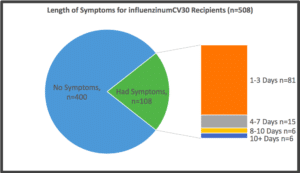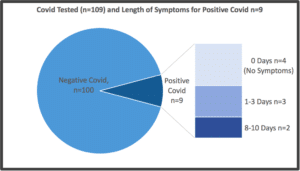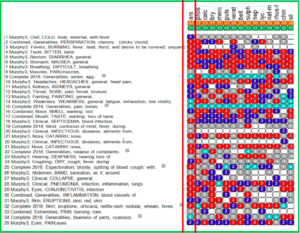View the slideshow presentation of this survey here. (Images below can be viewed more clearly in the slideshow presentation.)
Homeoprophylaxis (HP) is not aimed at treating disease, but instead increases the vitality of the individual, and thus increases innate immunity. In an effort to further explore this safe and natural homeopathic alternative to boosting immunity in defense of contracting illness, I undertook a casual survey based upon self-reporting by recipients of homeoprophylaxis described below.
Objectives
The objectives of this casual observation were to understand how homeoprophylactic influenzinumCV could affect the type, intensity, and duration of symptoms typical of SARS-CoV-2 infections and/or seasonal flu-like illnesses.
Methodology
Methodology included the preparation of vials of influenzinum CV30. They were distributed to the recipients between January 2020 and August 2020. 508 participants then completed a self-administered online survey after administering at least one oral dose of influenzinum CV30. All surveys were completed by the 30th of September 2020, and data was summarized from responses.
Remedy Choice
Selection of the remedy was made in consultation with Dr. Isaac Golden, the world’s leading authority on homeoprophylaxis. Multiple historical strains of influenza plus the inclusion of pneumococcinum to prevent sequelae of respiratory symptoms were determined to be an effective choice. Dr. Golden also recommended that “genus epidemicus” (GE) remedies could be included as determined.
GE remedies are remedies that match the common symptoms in current cases. This can be a moving target. As things mutate, we see different symptoms emerge as more or less prominent, requiring the GE remedies to be adjusted accordingly. The inclusion of GE remedies were included for Cuba and India’s choices for prophylactics, but was not included in InfluenzinumCV. Our preparation was composed of:
Influenza A and B including:
- A/New Caledonia/20/99(H1N1) virus 30c
- A/Moscow/10/99(H3N2) virus 30c
- B/Sichuan/379/99 virus 30c
- Bacillinum 30c
- Pneumococcinum 30c
30c potency was chosen to avoid possible aggravations related to any unknown comorbidities, chronic conditions, or suppressive medications being taken by recipients. The directions given to the recipients were to take one dose in a clean mouth, 5 minutes away from any food. They could take one to four doses a month, depending on exposure. An alternate method would be to dissolve a dose in water, stir, and take a teaspoon of water per dose.
Some dosing variation was dependent upon exposure. If known exposure occurred, for instance family members living in the same home, the recommended dose was three times per week. If individuals had pre-existing chronic conditions, it was recommended that they dose in water and only once a month. And if traveling by air or being in large crowds, it was recommended that they dose prior to flying and once returning home.
Survey questions included were age, symptoms, including fever, nasal congestion, headache, body aches, shortness of breath and fatigue. Additionally, a question included indicating the duration of symptoms, either one to three days, four to seven, eight to 10 or more than 10 days. Were they tested for SARS-CoV-2 infections/ And was that negative or positive?
Findings
Findings included 400 of the 508 participants having no symptoms whatsoever. 108 had some symptoms. Of the 108 that had symptoms, 81 of them had symptoms lasting only one to three days. 15 of them had four to seven days, and then 6 had eight to ten days. And six had more than 10 days. (Figure 1.1)

Figure 1.1
109 people tested for COVID out of the group and nine tested positive. 100 tested negative, and nine tested positive. Of those nine that tested positive, four of them had no symptoms whatsoever. Three of them had symptoms for one to three days. And two of them had symptoms for eight to 10 days. No one had symptoms for more than 10 days. (Figure 2.1)

Figure 2.1
In the zero to 10-year-old age group, there were 99 respondents with 25 (25%) of them reporting having symptoms. In the 11 to 18-year-old age group, with 63 respondents, nine of them (under 15%) had symptoms. In the 19 to 29-year-old age group, with 42 respondents, 10 of them had some sort of symptoms. In the 30 to 49-year-old age group with 147 respondents. 37 of them had some symptoms. In the 50 to 64-year-old group, with 91 respondents, 18 had symptoms. And in the 65 and over group, with 66 respondents, only 9 had symptoms. We saw the greatest reporting of symptoms in the 30 to 49-year-old group.
Across the entire group of 109 respondents who experienced any symptoms fever was reported a total of 27 times. Nasal congestion was reported 74 times. Headache was reported 71 times, body aches, 47 times, shortness of breath, 16 times and fatigue, 56 times. The most predominant symptoms were nasal congestion and headache amongst the entire group. If we look at the specific symptoms by age, we see that fever was reported most, in the zero to 10-year-old group, possibly indicating the more robust immune response by children.
Headaches were reported predominantly by the 30 to 49 year-old-group. Body aches, also in the 30 to 49-year-olds. Shortness of breath had virtually no reports between zero and 29 years old, with a few reports between ages 30 and 49, with a few more in the 50 to 64-year-old group. Fatigue was seen most in the 30 to 49-year-old group, and we might be able to conclude that they’re parents of young children, so they’re also the busiest age group that’s losing sleep and most active.
Conclusion
In conclusion, the majority of participants (79%) had no symptoms whatsoever. 21% had mild symptoms. Those symptoms were primarily headache and nasal congestion. The duration of the symptoms were predominantly lasting one to three days for 75% of people. The majority of people using influenzinum CV did not test, even if they experienced symptoms. This may indicate that they had no fear, or anxiety, even though they had a few symptoms. The use of InfluenzinumCV seems to have had a positive effect on enhanced immunity, as evidenced by reduced frequency and shorter duration of symptoms, post administration of InfluenzinumCV, and definitely warrants further investigation.
Considerations to include for future research would be a screening for outliers, and comorbidities. It would also be helpful to gather information about nutritional supplementation being used, positive known exposures to the illness, gender of respondent, and region of the U.S.
So this is the additional information that I mentioned early that played into consideration. First of all, the risks that are associated with influenza vaccines. This was a recent study done in the 2017/18 flu season. Those who received flu vaccine had a 36% increase risk of being susceptible to all Corona viruses.
—————————————–
Addendum
Throughout the world, other various HP methodologies have also been employed.
- Some individuals used Oscillococcinum, an over-the-counter homeopathic product from Boron made from heats and liver of fowl. It has been effectively used for many years as a basic preventative during annual flu seasons.
- The government of India recommended using homeopathic Arsenicum album 30c. The Indian government positively endorses the use of homeoprophylaxis and determined that Arsenicum album would be the most helpful prophylactic based upon repertorization of symptoms. Repertorization is a homeopathic method utilizing different rubrics that reflect predominant symptoms, expressed by a specific infectious disease. (Figure 3.1)

Figure 3.1
- Cuba created a ‘combination remedy.’ Within their robust department of natural medicine, and the director of epidemiology within the ministry of public health, Johann Perdomo Delgado, stated, “Sublingual drops of the compound PrevenHo-Vir, prevent different diseases, such as influenza, the common cold, dengue, and emerging viral infections such as this one.”
- Sponsored by the Cuban Department of Natural Traditional Medicine, Ministry of Public Health, the inclusion criteria were: individuals between 18 and 64 without any respiratory symptoms at the time of administration, excluding anyone allergic to any components. They administered this in a diluted liquid form, with five drops diluted in an additional two ounces of drinking water, administered daily for three consecutive days. Another single dose was administered one week later on day 10. The liquid was retained it in their mouth for five seconds, guaranteeing sublingual contact.
- Free and Healthy Children International recommended using the homeopathic ‘nosode’ (a remedy prepared from exudate of the disease)
- Lastly, the ‘genus epidemicus,’ was recommended as well. This is a curative remedy chosen based on associated common symptoms once the illness is contracted and treated. The genus epidemicus remedy that was determined by a number of homeopathic physicians from hospitals in India, was homeopathic Mercurius.
Homeoprophylaxis is a safe and effective method to boost innate immunity in the presence of infectious disease. Learn more by downloading our free HP Information Sheet.


